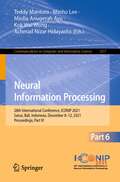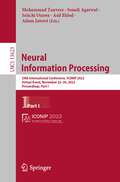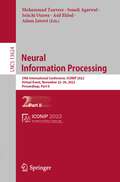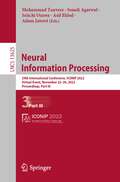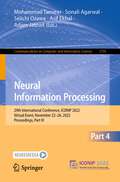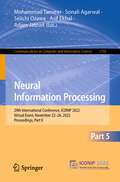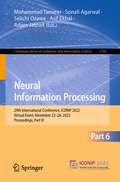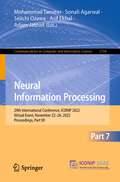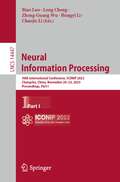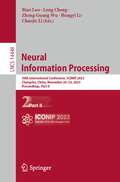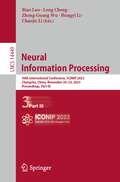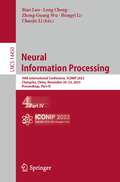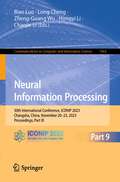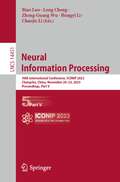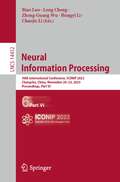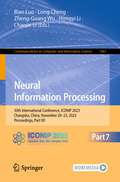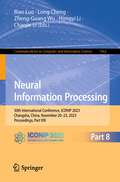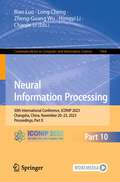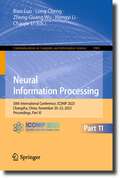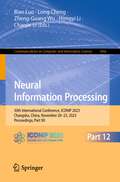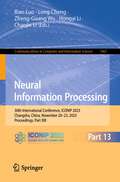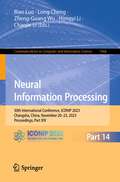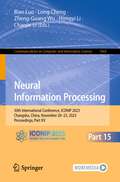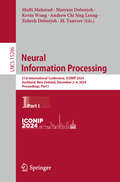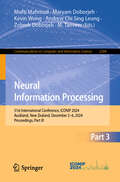- Table View
- List View
Neural Information Processing: 28th International Conference, ICONIP 2021, Sanur, Bali, Indonesia, December 8–12, 2021, Proceedings, Part VI (Communications in Computer and Information Science #1517)
by Minho Lee Kok Wai Wong Teddy Mantoro Media Anugerah Ayu Achmad Nizar HidayantoThe two-volume set CCIS 1516 and 1517 constitutes thoroughly refereed short papers presented at the 28th International Conference on Neural Information Processing, ICONIP 2021, held in Sanur, Bali, Indonesia, in December 2021.* The volume also presents papers from the workshop on Artificial Intelligence and Cyber Security, held during the ICONIP 2021. The 176 short and workshop papers presented in this volume were carefully reviewed and selected for publication out of 1093 submissions. The papers are organized in topical sections as follows: theory and algorithms; AI and cybersecurity; cognitive neurosciences; human centred computing; advances in deep and shallow machine learning algorithms for biomedical data and imaging; reliable, robust, and secure machine learning algorithms; theory and applications of natural computing paradigms; applications.* The conference was held virtually due to the COVID-19 pandemic.
Neural Information Processing: 29th International Conference, ICONIP 2022, Virtual Event, November 22–26, 2022, Proceedings, Part I (Lecture Notes in Computer Science #13623)
by Seiichi Ozawa Adam Jatowt Sonali Agarwal Mohammad Tanveer Asif EkbalThe three-volume set LNCS 13623, 13624, and 13625 constitutes the refereed proceedings of the 29th International Conference on Neural Information Processing, ICONIP 2022, held as a virtual event, November 22–26, 2022.The 146 papers presented in the proceedings set were carefully reviewed and selected from 810 submissions. They were organized in topical sections as follows: Theory and Algorithms; Cognitive Neurosciences; Human Centered Computing; and Applications.The ICONIP conference aims to provide a leading international forum for researchers, scientists, and industry professionals who are working in neuroscience, neural networks, deep learning, and related fields to share their new ideas, progress, and achievements.
Neural Information Processing: 29th International Conference, ICONIP 2022, Virtual Event, November 22–26, 2022, Proceedings, Part II (Lecture Notes in Computer Science #13624)
by Seiichi Ozawa Adam Jatowt Sonali Agarwal Mohammad Tanveer Asif EkbalThe three-volume set LNCS 13623, 13624, and 13625 constitutes the refereed proceedings of the 29th International Conference on Neural Information Processing, ICONIP 2022, held as a virtual event, November 22–26, 2022.The 146 papers presented in the proceedings set were carefully reviewed and selected from 810 submissions. They were organized in topical sections as follows: Theory and Algorithms; Cognitive Neurosciences; Human Centered Computing; and Applications.The ICONIP conference aims to provide a leading international forum for researchers, scientists, and industry professionals who are working in neuroscience, neural networks, deep learning, and related fields to share their new ideas, progress, and achievements.
Neural Information Processing: 29th International Conference, ICONIP 2022, Virtual Event, November 22–26, 2022, Proceedings, Part III (Lecture Notes in Computer Science #13625)
by Seiichi Ozawa Adam Jatowt Sonali Agarwal Mohammad Tanveer Asif EkbalThe three-volume set LNCS 13623, 13624, and 13625 constitutes the refereed proceedings of the 29th International Conference on Neural Information Processing, ICONIP 2022, held as a virtual event, November 22–26, 2022. The 146 papers presented in the proceedings set were carefully reviewed and selected from 810 submissions. They were organized in topical sections as follows: Theory and Algorithms; Cognitive Neurosciences; Human Centered Computing; and Applications.The ICONIP conference aims to provide a leading international forum for researchers, scientists, and industry professionals who are working in neuroscience, neural networks, deep learning, and related fields to share their new ideas, progress, and achievements.
Neural Information Processing: 29th International Conference, ICONIP 2022, Virtual Event, November 22–26, 2022, Proceedings, Part IV (Communications in Computer and Information Science #1791)
by Seiichi Ozawa Adam Jatowt Sonali Agarwal Mohammad Tanveer Asif EkbalThe four-volume set CCIS 1791, 1792, 1793 and 1794 constitutes the refereed proceedings of the 29th International Conference on Neural Information Processing, ICONIP 2022, held as a virtual event, November 22–26, 2022. The 213 papers presented in the proceedings set were carefully reviewed and selected from 810 submissions. They were organized in topical sections as follows: Theory and Algorithms; Cognitive Neurosciences; Human Centered Computing; and Applications.The ICONIP conference aims to provide a leading international forum for researchers, scientists, and industry professionals who are working in neuroscience, neural networks, deep learning, and related fields to share their new ideas, progress, and achievements.
Neural Information Processing: 29th International Conference, ICONIP 2022, Virtual Event, November 22–26, 2022, Proceedings, Part V (Communications in Computer and Information Science #1792)
by Seiichi Ozawa Adam Jatowt Sonali Agarwal Mohammad Tanveer Asif EkbalThe four-volume set CCIS 1791, 1792, 1793 and 1794 constitutes the refereed proceedings of the 29th International Conference on Neural Information Processing, ICONIP 2022, held as a virtual event, November 22–26, 2022. The 213 papers presented in the proceedings set were carefully reviewed and selected from 810 submissions. They were organized in topical sections as follows: Theory and Algorithms; Cognitive Neurosciences; Human Centered Computing; and Applications.The ICONIP conference aims to provide a leading international forum for researchers, scientists, and industry professionals who are working in neuroscience, neural networks, deep learning, and related fields to share their new ideas, progress, and achievements.
Neural Information Processing: 29th International Conference, ICONIP 2022, Virtual Event, November 22–26, 2022, Proceedings, Part VI (Communications in Computer and Information Science #1793)
by Seiichi Ozawa Adam Jatowt Sonali Agarwal Mohammad Tanveer Asif EkbalThe four-volume set CCIS 1791, 1792, 1793 and 1794 constitutes the refereed proceedings of the 29th International Conference on Neural Information Processing, ICONIP 2022, held as a virtual event, November 22–26, 2022. The 213 papers presented in the proceedings set were carefully reviewed and selected from 810 submissions. They were organized in topical sections as follows: Theory and Algorithms; Cognitive Neurosciences; Human Centered Computing; and Applications.The ICONIP conference aims to provide a leading international forum for researchers, scientists, and industry professionals who are working in neuroscience, neural networks, deep learning, and related fields to share their new ideas, progress, and achievements.
Neural Information Processing: 29th International Conference, ICONIP 2022, Virtual Event, November 22–26, 2022, Proceedings, Part VII (Communications in Computer and Information Science #1794)
by Seiichi Ozawa Adam Jatowt Sonali Agarwal Mohammad Tanveer Asif EkbalThe four-volume set CCIS 1791, 1792, 1793 and 1794 constitutes the refereed proceedings of the 29th International Conference on Neural Information Processing, ICONIP 2022, held as a virtual event, November 22–26, 2022. The 213 papers presented in the proceedings set were carefully reviewed and selected from 810 submissions. They were organized in topical sections as follows: Theory and Algorithms; Cognitive Neurosciences; Human Centered Computing; and Applications.The ICONIP conference aims to provide a leading international forum for researchers, scientists, and industry professionals who are working in neuroscience, neural networks, deep learning, and related fields to share their new ideas, progress, and achievements.
Neural Information Processing: 30th International Conference, ICONIP 2023, Changsha, China, November 20–23, 2023, Proceedings, Part I (Lecture Notes in Computer Science #14447)
by Hongyi Li Long Cheng Zheng-Guang Wu Biao Luo Chaojie LiThe six-volume set LNCS 14447 until 14452 constitutes the refereed proceedings of the 30th International Conference on Neural Information Processing, ICONIP 2023, held in Changsha, China, in November 2023. The 652 papers presented in the proceedings set were carefully reviewed and selected from 1274 submissions. They focus on theory and algorithms, cognitive neurosciences; human centred computing; applications in neuroscience, neural networks, deep learning, and related fields.
Neural Information Processing: 30th International Conference, ICONIP 2023, Changsha, China, November 20–23, 2023, Proceedings, Part II (Lecture Notes in Computer Science #14448)
by Hongyi Li Long Cheng Zheng-Guang Wu Biao Luo Chaojie LiThe six-volume set LNCS 14447 until 14452 constitutes the refereed proceedings of the 30th International Conference on Neural Information Processing, ICONIP 2023, held in Changsha, China, in November 2023. The 652 papers presented in the proceedings set were carefully reviewed and selected from 1274 submissions. They focus on theory and algorithms, cognitive neurosciences; human centred computing; applications in neuroscience, neural networks, deep learning, and related fields.
Neural Information Processing: 30th International Conference, ICONIP 2023, Changsha, China, November 20–23, 2023, Proceedings, Part III (Lecture Notes in Computer Science #14449)
by Hongyi Li Long Cheng Zheng-Guang Wu Biao Luo Chaojie LiThe six-volume set LNCS 14447 until 14452 constitutes the refereed proceedings of the 30th International Conference on Neural Information Processing, ICONIP 2023, held in Changsha, China, in November 2023. The 652 papers presented in the proceedings set were carefully reviewed and selected from 1274 submissions. They focus on theory and algorithms, cognitive neurosciences; human centred computing; applications in neuroscience, neural networks, deep learning, and related fields.
Neural Information Processing: 30th International Conference, ICONIP 2023, Changsha, China, November 20–23, 2023, Proceedings, Part IV (Lecture Notes in Computer Science #14450)
by Hongyi Li Long Cheng Zheng-Guang Wu Biao Luo Chaojie LiThe six-volume set LNCS 14447 until 14452 constitutes the refereed proceedings of the 30th International Conference on Neural Information Processing, ICONIP 2023, held in Changsha, China, in November 2023. The 652 papers presented in the proceedings set were carefully reviewed and selected from 1274 submissions. They focus on theory and algorithms, cognitive neurosciences; human centred computing; applications in neuroscience, neural networks, deep learning, and related fields.
Neural Information Processing: 30th International Conference, ICONIP 2023, Changsha, China, November 20–23, 2023, Proceedings, Part IX (Communications in Computer and Information Science #1963)
by Hongyi Li Long Cheng Zheng-Guang Wu Biao Luo Chaojie LiThe nine-volume set constitutes the refereed proceedings of the 30th International Conference on Neural Information Processing, ICONIP 2023, held in Changsha, China, in November 2023. The 1274 papers presented in the proceedings set were carefully reviewed and selected from 652 submissions. The ICONIP conference aims to provide a leading international forum for researchers, scientists, and industry professionals who are working in neuroscience, neural networks, deep learning, and related fields to share their new ideas, progress, and achievements.
Neural Information Processing: 30th International Conference, ICONIP 2023, Changsha, China, November 20–23, 2023, Proceedings, Part V (Lecture Notes in Computer Science #14451)
by Hongyi Li Long Cheng Zheng-Guang Wu Biao Luo Chaojie LiThe six-volume set LNCS 14447 until 14452 constitutes the refereed proceedings of the 30th International Conference on Neural Information Processing, ICONIP 2023, held in Changsha, China, in November 2023. The 652 papers presented in the proceedings set were carefully reviewed and selected from 1274 submissions. They focus on theory and algorithms, cognitive neurosciences; human centred computing; applications in neuroscience, neural networks, deep learning, and related fields.
Neural Information Processing: 30th International Conference, ICONIP 2023, Changsha, China, November 20–23, 2023, Proceedings, Part VI (Lecture Notes in Computer Science #14452)
by Hongyi Li Long Cheng Zheng-Guang Wu Biao Luo Chaojie LiThe six-volume set LNCS 14447 until 14452 constitutes the refereed proceedings of the 30th International Conference on Neural Information Processing, ICONIP 2023, held in Changsha, China, in November 2023. The 652 papers presented in the proceedings set were carefully reviewed and selected from 1274 submissions. They focus on theory and algorithms, cognitive neurosciences; human centred computing; applications in neuroscience, neural networks, deep learning, and related fields.
Neural Information Processing: 30th International Conference, ICONIP 2023, Changsha, China, November 20–23, 2023, Proceedings, Part VII (Communications in Computer and Information Science #1961)
by Hongyi Li Long Cheng Zheng-Guang Wu Biao Luo Chaojie LiThe nine-volume set constitutes the refereed proceedings of the 30th International Conference on Neural Information Processing, ICONIP 2023, held in Changsha, China, in November 2023. The 1274 papers presented in the proceedings set were carefully reviewed and selected from 652 submissions. The ICONIP conference aims to provide a leading international forum for researchers, scientists, and industry professionals who are working in neuroscience, neural networks, deep learning, and related fields to share their new ideas, progress, and achievements.
Neural Information Processing: 30th International Conference, ICONIP 2023, Changsha, China, November 20–23, 2023, Proceedings, Part VIII (Communications in Computer and Information Science #1962)
by Hongyi Li Long Cheng Zheng-Guang Wu Biao Luo Chaojie LiThe nine-volume set constitutes the refereed proceedings of the 30th International Conference on Neural Information Processing, ICONIP 2023, held in Changsha, China, in November 2023. The 1274 papers presented in the proceedings set were carefully reviewed and selected from 652 submissions. The ICONIP conference aims to provide a leading international forum for researchers, scientists, and industry professionals who are working in neuroscience, neural networks, deep learning, and related fields to share their new ideas, progress, and achievements.
Neural Information Processing: 30th International Conference, ICONIP 2023, Changsha, China, November 20–23, 2023, Proceedings, Part X (Communications in Computer and Information Science #1964)
by Hongyi Li Long Cheng Zheng-Guang Wu Biao Luo Chaojie LiThe nine-volume set constitutes the refereed proceedings of the 30th International Conference on Neural Information Processing, ICONIP 2023, held in Changsha, China, in November 2023. The 1274 papers presented in the proceedings set were carefully reviewed and selected from 652 submissions. The ICONIP conference aims to provide a leading international forum for researchers, scientists, and industry professionals who are working in neuroscience, neural networks, deep learning, and related fields to share their new ideas, progress, and achievements.
Neural Information Processing: 30th International Conference, ICONIP 2023, Changsha, China, November 20–23, 2023, Proceedings, Part XI (Communications in Computer and Information Science #1965)
by Hongyi Li Long Cheng Zheng-Guang Wu Biao Luo Chaojie LiThe nine-volume set constitutes the refereed proceedings of the 30th International Conference on Neural Information Processing, ICONIP 2023, held in Changsha, China, in November 2023. The 1274 papers presented in the proceedings set were carefully reviewed and selected from 652 submissions. The ICONIP conference aims to provide a leading international forum for researchers, scientists, and industry professionals who are working in neuroscience, neural networks, deep learning, and related fields to share their new ideas, progress, and achievements.
Neural Information Processing: 30th International Conference, ICONIP 2023, Changsha, China, November 20–23, 2023, Proceedings, Part XII (Communications in Computer and Information Science #1966)
by Hongyi Li Long Cheng Zheng-Guang Wu Biao Luo Chaojie LiThe nine-volume set constitutes the refereed proceedings of the 30th International Conference on Neural Information Processing, ICONIP 2023, held in Changsha, China, in November 2023. The 1274 papers presented in the proceedings set were carefully reviewed and selected from 652 submissions. The ICONIP conference aims to provide a leading international forum for researchers, scientists, and industry professionals who are working in neuroscience, neural networks, deep learning, and related fields to share their new ideas, progress, and achievements.
Neural Information Processing: 30th International Conference, ICONIP 2023, Changsha, China, November 20–23, 2023, Proceedings, Part XIII (Communications in Computer and Information Science #1967)
by Hongyi Li Long Cheng Zheng-Guang Wu Biao Luo Chaojie LiThe nine-volume set constitutes the refereed proceedings of the 30th International Conference on Neural Information Processing, ICONIP 2023, held in Changsha, China, in November 2023. The 1274 papers presented in the proceedings set were carefully reviewed and selected from 652 submissions. The ICONIP conference aims to provide a leading international forum for researchers, scientists, and industry professionals who are working in neuroscience, neural networks, deep learning, and related fields to share their new ideas, progress, and achievements.
Neural Information Processing: 30th International Conference, ICONIP 2023, Changsha, China, November 20–23, 2023, Proceedings, Part XIV (Communications in Computer and Information Science #1968)
by Hongyi Li Long Cheng Zheng-Guang Wu Biao Luo Chaojie LiThe nine-volume set constitutes the refereed proceedings of the 30th International Conference on Neural Information Processing, ICONIP 2023, held in Changsha, China, in November 2023. The 1274 papers presented in the proceedings set were carefully reviewed and selected from 652 submissions. The ICONIP conference aims to provide a leading international forum for researchers, scientists, and industry professionals who are working in neuroscience, neural networks, deep learning, and related fields to share their new ideas, progress, and achievements.
Neural Information Processing: 30th International Conference, ICONIP 2023, Changsha, China, November 20–23, 2023, Proceedings, Part XV (Communications in Computer and Information Science #1969)
by Hongyi Li Long Cheng Zheng-Guang Wu Biao Luo Chaojie LiThe nine-volume set constitutes the refereed proceedings of the 30th International Conference on Neural Information Processing, ICONIP 2023, held in Changsha, China, in November 2023. The 1274 papers presented in the proceedings set were carefully reviewed and selected from 652 submissions. The ICONIP conference aims to provide a leading international forum for researchers, scientists, and industry professionals who are working in neuroscience, neural networks, deep learning, and related fields to share their new ideas, progress, and achievements.
Neural Information Processing: 31st International Conference, ICONIP 2024, Auckland, New Zealand, December 2–6, 2024, Proceedings, Part I (Lecture Notes in Computer Science #15286)
by Kevin Wong M. Tanveer Mufti Mahmud Maryam Doborjeh Andrew Chi Sing Leung Zohreh DoborjehThe eleven-volume set LNCS 15286-15296 constitutes the refereed proceedings of the 31st International Conference on Neural Information Processing, ICONIP 2024, held in Auckland, New Zealand, in December 2024.The 318 regular papers presented in the proceedings set were carefully reviewed and selected from 1301 submissions. They focus on four main areas, namely: theory and algorithms; cognitive neurosciences; human-centered computing; and applications.
Neural Information Processing: 31st International Conference, ICONIP 2024, Auckland, New Zealand, December 2–6, 2024, Proceedings, Part III (Communications in Computer and Information Science #2284)
by Kevin Wong M. Tanveer Mufti Mahmud Maryam Doborjeh Andrew Chi Sing Leung Zohreh DoborjehThe sixteen-volume set, CCIS 2282-2297, constitutes the refereed proceedings of the 31st International Conference on Neural Information Processing, ICONIP 2024, held in Auckland, New Zealand, in December 2024. The 472 regular papers presented in this proceedings set were carefully reviewed and selected from 1301 submissions. These papers primarily focus on the following areas: Theory and algorithms; Cognitive neurosciences; Human-centered computing; and Applications.
